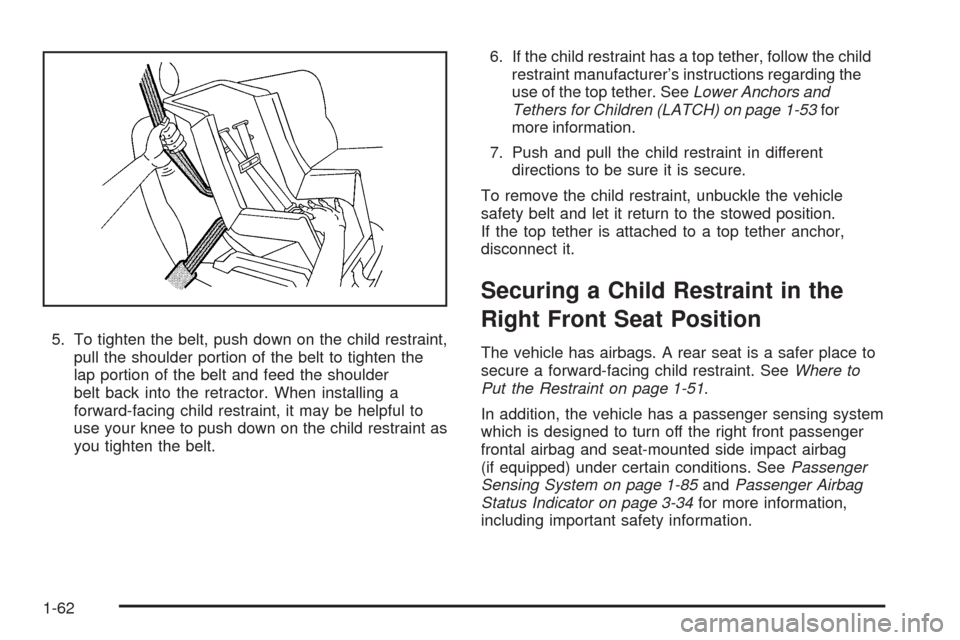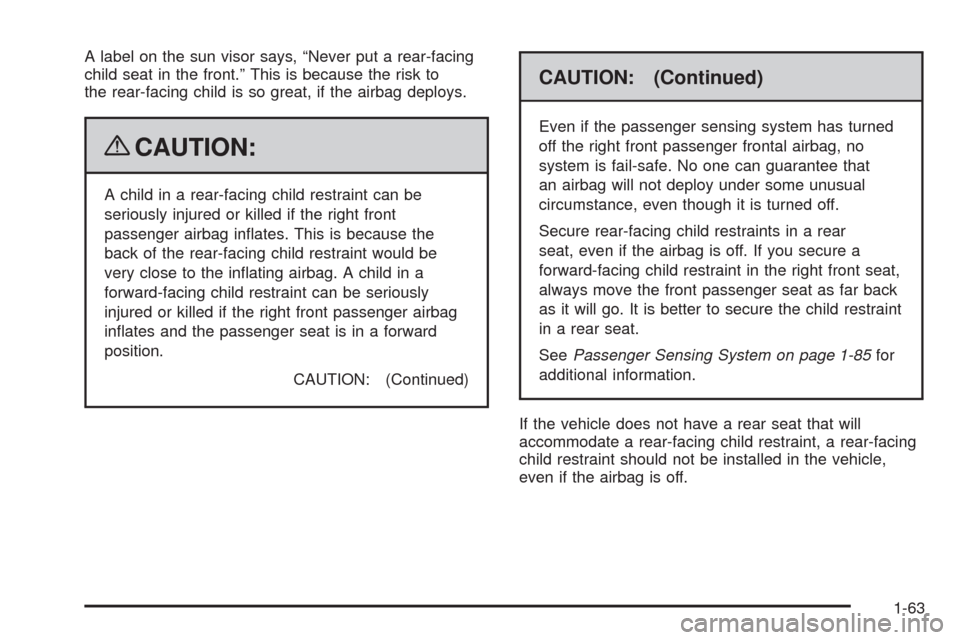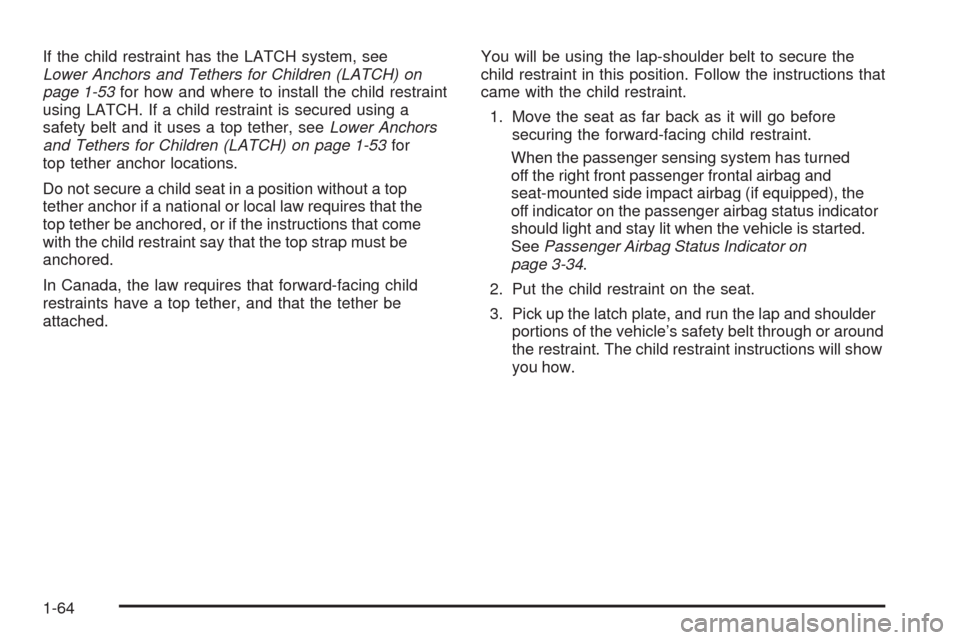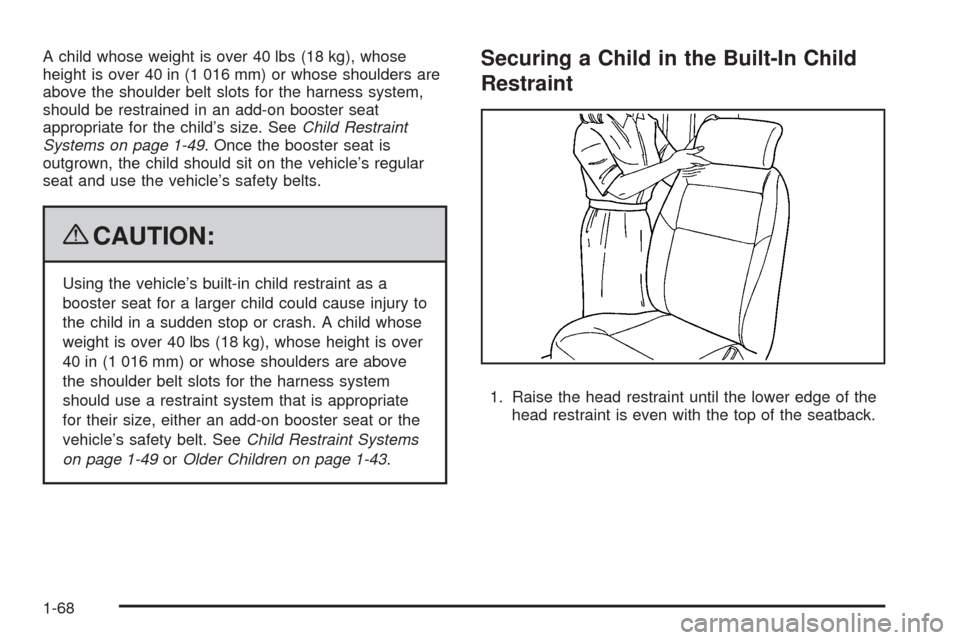Page 64 of 464

If the position you are
using has an adjustable
headrest or head restraint
and you are using a
single tether, raise the
headrest or head restraint
and route the tether
under the headrest or head
restraint and in between
the headrest or head
restraint posts.
3. Push and pull the child restraint in different
directions to be sure it is secure.
Securing a Child Restraint in a Rear
Seat Position
When securing a child restraint in a rear seating position,
study the instructions that came with the child restraint to
make sure it is compatible with this vehicle.
If the child restraint has the LATCH system, seeLower
Anchors and Tethers for Children (LATCH) on page 1-53
for how and where to install the child restraint using
LATCH. If a child restraint is secured in the vehicle usinga safety belt and it uses a top tether, seeLower Anchors
and Tethers for Children (LATCH) on page 1-53for top
tether anchor locations.
Do not secure a child seat in a position without a top
tether anchor if a national or local law requires that
the top tether be anchored, or if the instructions
that come with the child restraint say that the top
strap must be anchored.
In Canada, the law requires that forward-facing child
restraints have a top tether, and that the tether be
attached.
If the child restraint does not have the LATCH system,
you will be using the safety belt to secure the child
restraint in this position. Be sure to follow the instructions
that came with the child restraint. Secure the child in the
child restraint when and as the instructions say.
If more than one child restraint needs to be installed
in the rear seat, be sure to readWhere to Put the
Restraint on page 1-51.
1. Put the child restraint on the seat.
2. Pick up the latch plate, and run the lap and shoulder
portions of the vehicle’s safety belt through or
around the restraint. The child restraint instructions
will show you how.
1-60
Page 66 of 464

5. To tighten the belt, push down on the child restraint,
pull the shoulder portion of the belt to tighten the
lap portion of the belt and feed the shoulder
belt back into the retractor. When installing a
forward-facing child restraint, it may be helpful to
use your knee to push down on the child restraint as
you tighten the belt.6. If the child restraint has a top tether, follow the child
restraint manufacturer’s instructions regarding the
use of the top tether. SeeLower Anchors and
Tethers for Children (LATCH) on page 1-53for
more information.
7. Push and pull the child restraint in different
directions to be sure it is secure.
To remove the child restraint, unbuckle the vehicle
safety belt and let it return to the stowed position.
If the top tether is attached to a top tether anchor,
disconnect it.
Securing a Child Restraint in the
Right Front Seat Position
The vehicle has airbags. A rear seat is a safer place to
secure a forward-facing child restraint. SeeWhere to
Put the Restraint on page 1-51.
In addition, the vehicle has a passenger sensing system
which is designed to turn off the right front passenger
frontal airbag and seat-mounted side impact airbag
(if equipped) under certain conditions. SeePassenger
Sensing System on page 1-85andPassenger Airbag
Status Indicator on page 3-34for more information,
including important safety information.
1-62
Page 67 of 464

A label on the sun visor says, “Never put a rear-facing
child seat in the front.” This is because the risk to
the rear-facing child is so great, if the airbag deploys.
{CAUTION:
A child in a rear-facing child restraint can be
seriously injured or killed if the right front
passenger airbag in�ates. This is because the
back of the rear-facing child restraint would be
very close to the in�ating airbag. A child in a
forward-facing child restraint can be seriously
injured or killed if the right front passenger airbag
in�ates and the passenger seat is in a forward
position.
CAUTION: (Continued)
CAUTION: (Continued)
Even if the passenger sensing system has turned
off the right front passenger frontal airbag, no
system is fail-safe. No one can guarantee that
an airbag will not deploy under some unusual
circumstance, even though it is turned off.
Secure rear-facing child restraints in a rear
seat, even if the airbag is off. If you secure a
forward-facing child restraint in the right front seat,
always move the front passenger seat as far back
as it will go. It is better to secure the child restraint
in a rear seat.
SeePassenger Sensing System on page 1-85for
additional information.
If the vehicle does not have a rear seat that will
accommodate a rear-facing child restraint, a rear-facing
child restraint should not be installed in the vehicle,
even if the airbag is off.
1-63
Page 68 of 464

If the child restraint has the LATCH system, see
Lower Anchors and Tethers for Children (LATCH) on
page 1-53for how and where to install the child restraint
using LATCH. If a child restraint is secured using a
safety belt and it uses a top tether, seeLower Anchors
and Tethers for Children (LATCH) on page 1-53for
top tether anchor locations.
Do not secure a child seat in a position without a top
tether anchor if a national or local law requires that the
top tether be anchored, or if the instructions that come
with the child restraint say that the top strap must be
anchored.
In Canada, the law requires that forward-facing child
restraints have a top tether, and that the tether be
attached.You will be using the lap-shoulder belt to secure the
child restraint in this position. Follow the instructions that
came with the child restraint.
1. Move the seat as far back as it will go before
securing the forward-facing child restraint.
When the passenger sensing system has turned
off the right front passenger frontal airbag and
seat-mounted side impact airbag (if equipped), the
off indicator on the passenger airbag status indicator
should light and stay lit when the vehicle is started.
SeePassenger Airbag Status Indicator on
page 3-34.
2. Put the child restraint on the seat.
3. Pick up the latch plate, and run the lap and shoulder
portions of the vehicle’s safety belt through or around
the restraint. The child restraint instructions will show
you how.
1-64
Page 70 of 464
6. To tighten the belt, push down on the child restraint,
pull the shoulder portion of the belt to tighten the lap
portion of the belt and feed the shoulder belt back
into the retractor. When installing a forward-facing
child restraint, it may be helpful to use your knee
to push down on the child restraint as you tighten
the belt.
7. Push and pull the child restraint in different
directions to be sure it is secure.If the airbags are off, the off indicator in the passenger
airbag status indicator will come on and stay on when the
vehicle is started.
If a child restraint has been installed and the on
indicator is lit, see “If the On Indicator is Lit for a Child
Restraint ” underPassenger Sensing System on
page 1-85for more information.
To remove the child restraint, unbuckle the vehicle
safety belt and let it return to the stowed position.
1-66
Page 72 of 464

A child whose weight is over 40 lbs (18 kg), whose
height is over 40 in (1 016 mm) or whose shoulders are
above the shoulder belt slots for the harness system,
should be restrained in an add-on booster seat
appropriate for the child’s size. SeeChild Restraint
Systems on page 1-49. Once the booster seat is
outgrown, the child should sit on the vehicle’s regular
seat and use the vehicle’s safety belts.
{CAUTION:
Using the vehicle’s built-in child restraint as a
booster seat for a larger child could cause injury to
the child in a sudden stop or crash. A child whose
weight is over 40 lbs (18 kg), whose height is over
40 in (1 016 mm) or whose shoulders are above
the shoulder belt slots for the harness system
should use a restraint system that is appropriate
for their size, either an add-on booster seat or the
vehicle’s safety belt. SeeChild Restraint Systems
on page 1-49orOlder Children on page 1-43.
Securing a Child in the Built-In Child
Restraint
1. Raise the head restraint until the lower edge of the
head restraint is even with the top of the seatback.
1-68
Page 74 of 464
You will be using the child restraint’s harness (A)
to secure your child. Do not use the vehicle’s
safety belts.
{CAUTION:
Using the vehicle’s regular safety belts on a child
seated on the built-in child restraint cushion can
cause serious injury to the child in a sudden stop
or crash. Secure the child using the built-in child
restraint’s harness.
WARNING:FAILURE TO FOLLOW THE
MANUFACTURER’S INSTRUCTIONS ON THE
USE OF THIS CHILD RESTRAINT SYSTEM CAN
RESULT IN YOUR CHILD STRIKING THE
VEHICLE’S INTERIOR DURING A SUDDEN
STOP OR CRASH.
SNUGLY ADJUST THE BELTS PROVIDED WITH
THIS CHILD RESTRAINT AROUND YOUR CHILD.
1-70
Page 75 of 464
4. Before placing the child in the child restraint, add
slack to the shoulder harness. Pull the black
shoulder harness release strap �rmly. At the same
time pull both shoulder harness straps through
the slots in the seatback as shown.
5. Place the child on the child restraint cushion.6. Select only one side of the harness. Place the
harness over the child’s shoulder.
7. Push the latch plate (A) into the buckle until it
clicks.
Be sure the buckle is free of any foreign objects
that may prevent you from securing the latch plates.
If you can not secure a latch plate, see your
dealer/retailer for service before using the child
restraint.
8. Place the other side of the harness over the child’s
shoulder.
9. Push the latch plate into the buckle until it clicks.
1-71